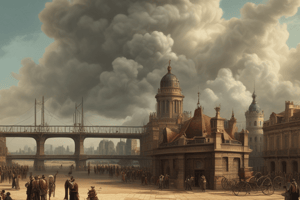Podcast
Questions and Answers
What was one of the main causes of industrial revolution riots during the 19th century?
What was one of the main causes of industrial revolution riots during the 19th century?
- Economic changes resulting in job loss for skilled artisans and farmers (correct)
- Improved transportation systems for goods
- Increased government regulations on industrial activities
- Expansion of educational opportunities for workers
What was a common challenge faced by many workers during the Industrial Revolution?
What was a common challenge faced by many workers during the Industrial Revolution?
- Low wages and high unemployment rates (correct)
- Generous benefits and high job security
- Flexible working hours and excellent pay
- Abundant job opportunities in various sectors
What aspect of the Industrial Revolution fueled the desire for better working conditions and wages?
What aspect of the Industrial Revolution fueled the desire for better working conditions and wages?
- Increased availability of luxury goods
- Economic prosperity for all social classes
- Improved access to healthcare for workers
- Poor working conditions in factories and mines (correct)
What resulted from the shift in the economy towards machine-made textiles and manufactured goods?
What resulted from the shift in the economy towards machine-made textiles and manufactured goods?
What role did economic instability play during the Industrial Revolution?
What role did economic instability play during the Industrial Revolution?
What was the main goal of the Luddite protests during the Industrial Revolution?
What was the main goal of the Luddite protests during the Industrial Revolution?
What was the primary cause of the Swing Riots in rural England during the Industrial Revolution?
What was the primary cause of the Swing Riots in rural England during the Industrial Revolution?
What was the significance of the Match Girls' Strike in 1888 during the Industrial Revolution?
What was the significance of the Match Girls' Strike in 1888 during the Industrial Revolution?
What impact did the riots and protests during the Industrial Revolution have on the fight for workers' rights?
What impact did the riots and protests during the Industrial Revolution have on the fight for workers' rights?
What was one of the notable effects of the Industrial Revolution on political and social awareness?
What was one of the notable effects of the Industrial Revolution on political and social awareness?
Flashcards are hidden until you start studying
Study Notes
The 19th Century Riots and the Industrial Revolution
The 19th century saw a series of riots and protests in various parts of the world, driven by the rapid industrialization and its impact on society. This article will focus on the causes of industrial revolution riots during this period, particularly in Britain and the United States.
Causes of Industrial Revolution Riots
Several factors contributed to the riots and protests during the Industrial Revolution:
-
Economic changes: The Industrial Revolution led to a significant shift in the economy, with a focus on machine-made textiles and other manufactured goods. This transition resulted in a loss of jobs and income for many skilled artisans and farmers, leading to resentment and frustration.
-
Low wages and unemployment: As the industrialization process continued, many workers faced low wages and high unemployment rates. This economic instability made it difficult for families to survive, leading to unrest and dissatisfaction.
-
Poor working conditions: Workers in factories and mines often faced harsh conditions, such as long hours, poor pay, and unsafe working environments. These conditions fueled the desire for better working conditions and wages.
-
Political and social reform: The Industrial Revolution also brought about a rise in political and social awareness, with many people demanding changes in the way society was organized and governed. This demand led to the formation of labor unions and political groups that advocated for workers' rights.
Notable Riots and Protests
Some notable riots and protests during the Industrial Revolution include:
-
Luddite protests: These protests were led by a group of English farm workers who destroyed the threshing machines that were replacing their jobs. The Luddites protested against the use of machines that took away their livelihoods and demanded better wages and working conditions.
-
Swing Riots: These disturbances occurred in parts of rural England in the second half of 1830 and were driven by low wages, unemployment, and poor harvests. Farm workers protested against the introduction of threshing machines and the loss of their jobs.
-
Match Girls' Strike in 1888: This strike in the United States led by women workers demanded better wages and working conditions in the match industry. The strike resulted in significant improvements in wages and working conditions for the strikers.
The riots and protests during the Industrial Revolution marked a turning point in the fight for workers' rights and the establishment of labor unions. These events also led to political and social reforms that aimed to improve the lives of the working class and address the issues that fueled the unrest.
Studying That Suits You
Use AI to generate personalized quizzes and flashcards to suit your learning preferences.





